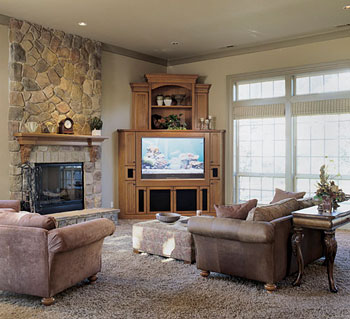Creating a Soundproofed Space
Designing a home with a great room feature requires professional guidance in the art of soundproofing. The key to soundproofing is to limit or block sound vibration that is traveling through the air. There are several effective methods for achieving a quiet room and typically you’ll want to employ more than one.
Adding a layer of drywall will help dampen sound in a great room. You'll want to check out "Air Renew" drywall by CertainTeed® which is improves indoor air quality and protects your walls.
You can start by blocking airflow from outside the home through traditional means such as storm doors and windows. Next, you need to address sound passing through walls, ceilings and floors. Soundproofing is rated using a system called STC (Sound Transmission Class) using a range of different frequencies. The higher the rating, the lower the noise level in your home. If you’ve ever stayed in a noisy hotel room, you’ve experienced a low STC rating.
Use storm windows and doors to seal off noise outside your home. Ply Gem Windows® offers a full-line of new construction windows an doors.
Common Soundproofing Methods
Sealing Air Holes in Your Home
Air can find its way into your home through any opening, large or small. Sealing air holes in your home will lower your energy costs and reduce noise. Installing storm doors and windows ensures minimal air leaks and builds a sound barrier between the outside and inside of your home. Additionally, consider caulking around pipes, outlets and other smaller opening in walls where air can flow.
Adding Ceiling or Wall Mass
A simple, yet relatively inexpensive way to add more mass to your walls is to add layers of drywall. Mass will also be affected by the quality of the materials you choose, for example heavier gypsum vs. lightweight fiberboard. Your concrete subflooring should be of sufficient mass to absorb sound as well.
Insulate Against Sound
Insulation absorbs sound vibrations and blocks noise traveling from room to room in your home. Today, insulation is available in a wide variety of materials from cellulose and fiberglass, to “itch-free” and recycled fibers. Insulation is given an R-value to measure performance. The R-value should be clearly marked on the insulation packaging.



.png)
.png)



